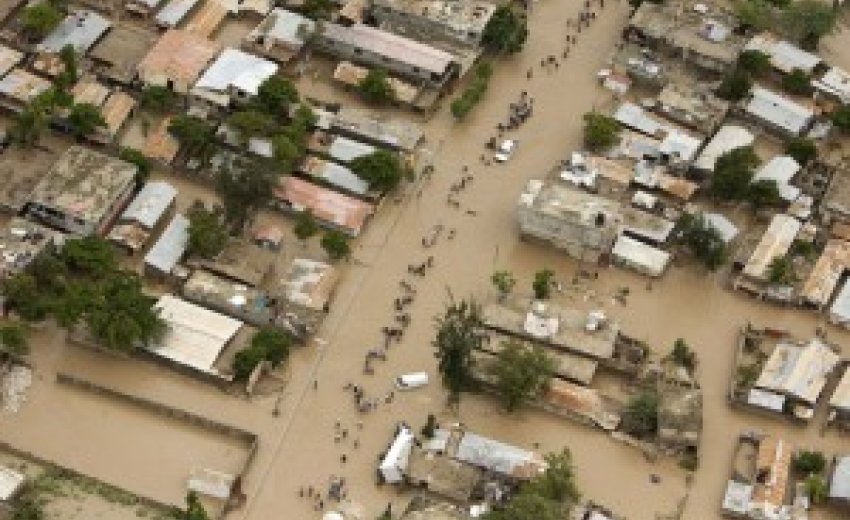Haiti Flails in Sandy's Wake
 |
| Richemond Gary, a 33-year-old mechanic in the farming town of Marin-Foujy, on Saturday tossed a rock at the site of his home, which was washed away by the muddy torrent of Rivière Grise during Hurricane Sandy |
-------------------------
Belated hurricane relief headed to battered Caribbean islands
Carol J. Williams in Los Angeles
Source
 |
| Residents make their way through the flooded streets of La Plaine, in northwest Haiti. Credit: Carl Juste / Miami Herald |
November 2, 2012: United Nations relief agencies are heading up a global mission to bring food, shelter and construction materials to Caribbean islands battered by super storm Sandy last week -- a belated response by the world body whose New York headquarters and staff were themselves hard hit by the deluge.
After a three-day closure amid the torrential rains and disrupted power, communications and transportation, U.N. agencies have swung into action to organize emergency aid to Haiti and coordinate the dispatch of relief supplies throughout the Caribbean.
More than 1.2 million Haitians are facing "food insecurity" and at least 15,000 homes were destroyed when the huge storm's drenching periphery lashed the world's poorest nation, where about 350,000 were still homeless and sheltering in tents nearly three years after the devastating earthquake of January 2010.
A yearlong drought and damage from Hurricane Isaac in August had already taken their toll on food production in Haiti and Sandy has significantly worsened the crisis, Johan Peleman, head of the U.N. Office for the Coordination of Humanitarian Affairs in Haiti, told U.N. Radio in an interview.
"With this new tropical storm, we fear that a great deal of the harvest which was ongoing in the south of the country may have been destroyed completely," Peleman said.
Many of the rugged dirt roads that provide the only access to storm victims in Haiti's mountainous interior have been rendered impassible by the torrential rains of the last week, Peleman said.
In New York, U.N. officials said they had reports of at least 54 Haitians killed as a result of the storm. At least 11 people were reportedly killed in Cuba, where the storm damaged or destroyed 188,000 homes and inflicted severe damage on about 245,000 acres of the vital sugar crop in the eastern part of the island, a U.N. report estimated Wednesday.
The opposition Cuban Commission on Human Rights and National Reconciliation appealed to the government of President Raul Castro to allow foreign relief agencies to bring food and supplies to the stricken island. An array of religious and nongovernmental organizations, including Catholic Relief Services and Outreach Aid to the Americas, announced relief missions to Cuba, according to InterAction, an alliance of U.S.-based agencies. The Russian Ministry for Emergency Situations dispatched three plane-loads of aid for Cuba on Thursday, the Itar-Tass news agency reported.
Storm-related deaths were also reported in Jamaica, the Bahamas and the Dominican Republic, with the U.N. reporting at least 71 killed across the Caribbean in Sandy's wake.
----------------------
Haiti: More Than One Million People Face Food Insecurity, UN Says
Caribbean Journal staff
Source
 |
| Flooding in Haiti (MINUSTAH Photo: Logan Abassi) |
November 1, 2012: Approximately 1.2 million people in Haiti are facing food insecurity due to the residual effects of Hurricane Sandy, according to Johan Peleman, the head of the United Nations Office for the Coordination of Humanitarian Affairs’ operation in Haiti.
Between 15,000 and 20,000 people’s houses in Haiti have been destroyed, damaged or flooded by the storm, the UN said.
The OCHA said it was “particularly concerned” because of the long drought that followed this year’s earlier severe storm, Tropical Storm Isaac.
“Now, with this new tropical storm, we fear that a great deal of the harvest which was ongoing in the south of the country may have been destroyed completely,” Peleman said Thursday. “Already, the drought and the previous storm had hit the northern part of the country very badly, and we had seen the levels of food insecurity rise there — with the south being hit now, we are going to face in the next couple of months very serious problems of malnutrition and food insecurity.”
Another 350,000 people in Haiti are still living in temporary camps for people displaced by Haiti’s 2010 earthquake.
“The most vulnerable IDP’s [internally displaced persons] that were living in camps have been evacuated before the storm and we are now, with the humanitarian community and the UN family, repairing tents, handing out new tarpaulins so that they can go back to live in more favourable conditions because a lot of light structures were obviously completely destroyed by the storm,” Peleman said.
He also said that it was expected that the number of cholera cases in Haiti would surge.
“The country is relatively well-prepared, but it is also very vulnerable to this type of disaster, not just because of the poverty, but because of decades of deforestation and erosion,” he said.
The UN’s MINUSTAH peacekeeping mission in Haiti is currently working with Haiti’s government to deal with the continued impact of the storm, from helping with logistics to clearing roads.



